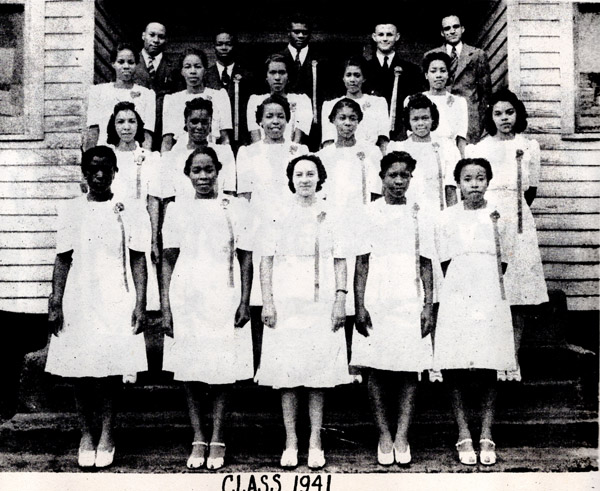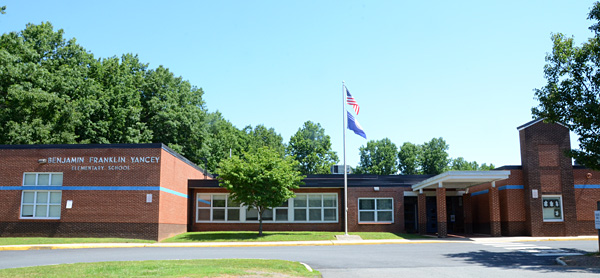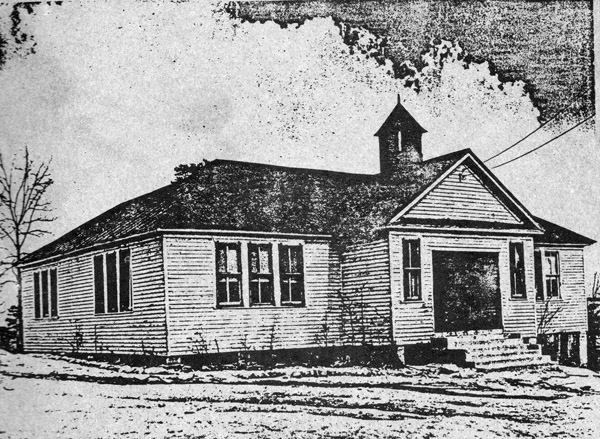|
Name: Esmont Colored School (later Esmont High School)
Date: 1916 to late 1930's
Image Number: Esmont High School Reunion, Sept. 27-29, 1991.
Comments: The Esmont Colored School shown above) was built in 1916 for $4000 and contained 6 rooms. This was the
fourth school for African-Americans built in Esmont. The first school for African-American students was built in September 1874,
and its first teacher was a white man named John Lane. Mr. Lane donated an additional acre of land to the school on which was built
a one-room log cabin for African-American students. Since there was no playground and the second school building was built in the woods, the
children had to play in the woods. In 1893, the School Board built a third school building which was a two-room affair, one room built over
the other one. By 1912, the men and women of Esmont had formed a School League, led by Benjamin F. Yancey, and this League worked together
to acquire and donate three acres of land to the school upon which the Esmont School Board placed the above 6-room building in 1916.
This fourth Esmont Colored School was located at 7625 Porters Road in Esmont.
The Esmont Colored School educated children in grades 1-8. Mr. Yancey, along with his wife, ran the school and taught young African-American
children basic skills. In the 1930's, the Esmont Colored School became so overcrowded that a two-room house nearby on Porters Road was
converted into more classroom space. The converted house was known as "The Little School" and took the grade school-aged children (kindergarten through
fourth grade). The above building was renamed 'Esmont High School' and taught African-American students in the 5th-11th grades.

Esmont High School Class of 1941
By the mid-1940's, the Esmont High School building was in poor physical condition. The Esmont black community
formed a Parent Teacher Association (PTA) and bought four more acres of land beside its current school building to permit future expansion to
better accommodate the growing student population. The PTA hoped that Albemarle County would replace their old high school building with
a "fine brick structure." In 1949, however, the Albemarle School Board combined Jefferson High School, Esmont High School, and Albemarle
Training School, black high schools in Charlottesville and Albemarle County, into a single high school for all the black students in this
area. The city purchased land from Jackson P. Burley, a teacher, church worker, and leader within the Charlottesville community and
constructed the new school on a seventeen-acre tract of land located on Rose Hill Drive. Construction began on the site in 1950, and in 1951 Burley High School opened for classes with a total of
542 students enrolled in grades 8-12. Finally, in 1961, Albemarle County built a fine brick structure on the old Esmont High School property,
which became B.F. Yancey Elementary School. Yancey ES finally closed in June 2017 after 56 years of elementary education at 7625
Porters Road in Esmont.
To learn more about Esmont School's history, read "From Esmont Colored School to B.F. Yancey Elementary School, 1916-1961" by Maxwell Johnson below:

From Esmont Colored School to B.F. Yancey Elementary School, 1916-1961
by Maxwell Johnson
The property occupied by Benjamin F. Yancey Elementary School is a monument to the high value placed on education by members of the
Esmont community. Local children, or, "scholars," as Mr. Yancey, an influential early 1900's Esmont educator, identified them
in his papers, attended schools that have stood at the Porters Road site for over a century.
Segregationist educational policies were in force in Albemarle County until the 1960's. As a result, black schools relied on
community and philanthropic support in addition to the insufficient aid provided by Albemarle County. Esmont's first standalone
black public school furnished by the county government was a two-room building put up in 1893. However, local residents soon found
it inadequate, forming The Educational Board of Esmont on January 24, 1907 in response.
The authors of the Board's constitution - A. Nelson, Chairman; J. Jones; B.F. Yancey; C.H. Nelson; and Reverend G.C. Cary - wrote,
"The object of this Board is to foster the cause of education and establish a better school."
It "shall appoint a Board of Trustees whose duty is to look after school property." For funding:
"The Revenue of this Board shall be by a regular tax from each [member]." An account was established in the board's name at Esmont
National Bank, too. This new educational organization was independent from the county schools' administration, operating as
"Patrons� to help the [neighborhood] public school."
Correspondence between Mr. Yancey; his wife, Harriet; and others convey their dedication to education in Esmont. (In addition to
teaching, Mr. Yancey shuffled between hotels in Virginia and West Virginia for work while school was out and worked as a painter in
Esmont. He also came into financial trouble of his own and suffered from recurring illness during his years as an educator.)
For example, Mr. Yancey extensively discusses funding for teachers and problems with the Educational Board in a June 1908 letter
addressed to his wife - despite at that time working in a Richmond hotel while on break for the summer.
The June 1908 letter contains references to the Jeanes Fund, a philanthropy that filled some of the Esmont School's funding gaps.
Mr. Yancey writes, "I went before Board of Directors of Jean [sic.] Fund and so the amt. has been sent [to] me." Anna T. Jeanes,
a Pennsylvania Quaker, began the fund in 1907 with a one million dollar endowment. Its official title was the "Negro Rural School Fund,"
and its purpose was to provide African-American vocational teachers and other educators to black schools. President William
Howard Taft, Andrew Carnegie, and Booker T. Washington were among its trustees.
Later, in February 1911, a Jeanes Fund teacher named Josephine Pride came to Esmont from Charlottesville. She was to teach a few
domestic science lessons in sewing and mat-making to Esmont School students. Another teacher, Rebecca Moore, who was likely from the
nearby Loving Charity black school supported by the wealthy Forsyth family, apparently got word of the upcoming lessons. Ms. Moore wrote
to Mr. Yancey, asking if her "older scholars [could] receive the instruction Miss Pride is giving." She also sent a letter to Mrs.
Forsyth, suggesting Forsyth enlist the help of Professor Alderman of the University of Virginia in an effort to pressure Ms. Pride into
letting Loving Charity students attend the upcoming vocational lessons at Esmont.
Ms. Pride was a passionate educator, but she had little patience for Ms. Moore's intrusions. Concerning her lack of response to Ms.
Moore's request, Josephine Pride writes bluntly in a March 1911 letter to Mrs. Yancey, "I don't have time to write to people I don't love."
(Ms. Pride starts the same letter by gently, but frankly, admonishing Mrs. Yancey:
"My dear, dear Mrs. Yancey, Lets [sic.] track this out, you are to address me as 'Josie' and not 'Miss Pride' any longer. It really grates on my finer sensibility, so you see you'll have to mend your ways.")
On December 22, 1914, the "Trustees of the Colored Peoples Educational Board of Esmont," who at that time were J.E. Bolding, James D.
Taylor, and Flemming Ford, deeded a roughly three acre parcel to the Scottsville District School Board of Albemarle County. J.C.
Crobarger had signed the parcel of land over to the Trustees earlier, in August 1911. The contract signed by the School Board and
the Trustees required that the "School Board shall erect and maintain on the property�a District School." It was to be
"a suitable school building," giving "the persons�the same or better advantages than they are now enjoying from said property."
This site eventually became B.F. Yancey Elementary School.
As promised, the School Board built a six-room schoolhouse about a year later in 1916. The new building could hold nearly two
hundred students. By the late 1930's, the Esmont school had become Esmont High School. Five educators were on its staff.
H.L. Summerall was its principal, and the teachers were Martha Hearns, Mrs. Helen Southall, Pocahontas Sellers, and Marguerite Brown.
Parents of Esmont High School students continued to provide financial support for education, forming the Parent-Teacher League in 1937,
which combined the previously separate men's and women's leagues.
Unfortunately, the "new" school was in poor condition by the mid-1940's. In May 1944, Esmont student Gladys Henderson, writing for the
Esmont High School Journal, described the six-room school as having "(dirty) walls, smeared window panes and patched floors."
Another student, Oscar White, wrote in the 1945 senior class poem, "The building may sag, but will not go down" (followed by:
"Hope grows stronger as it nears the ground"). Thus, parents in Esmont's black community rallied again to get a respectable modern building
from the Albemarle County School Board. Their newly formed Parent-Teacher Association (PTA) - fully accredited by the state PTA - bought
four more acres of land. According to a 1940's Esmont yearbook, the PTA hoped the School Board would replace the then-current building with
"a fine brick structure."
Benjamin F. Yancey Elementary School was founded in 1960 and named after the teacher, who came into Albemarle County
in the late 1800's to create a school for African Americans. In 1961, Albemarle County completed a fine brick
structure at 7625 Porters Road in Esmont on the 7 acres of Esmont Colored School property procured by Esmont's black community. Yancey
School housed only kindergarten through fifth grade students, with sixth-eighth grade students attending Walton Middle School. Albemarle
County's black high schools (including Esmont HS students) also had consolidated into Jackson P. Burley High School in Charlottesville a decade
earlier. In 1964 the Civil Rights Act, outlawing discrimination based on race and guaranteeing equal educational opportunities,
was passed. B.F. Yancey Elementary School became desegregated and slowly grew and adapted to a new diverse student body.

B.F. Yancey Elementary School, June 2017
Yancey Elementary School was the product of numerous expansions and renovation, and by 2017, it
occupied 27,000 feet of property. That expansion is a testament to the efforts and dedication of the Esmont community to develop and
broaden educational opportunities for each new generation of young scholars. By the 2016-2017 school year, however, Yancey's school
population had declined to 118 students as a result of limited development and economic activity in this rural area of Southern Albemarle. Additionally,
the availability of federal funding to provide equitable access to services needed by Yancey students was uncertain. As a result,
Albemarle County Public Schools voted to close Yancey Elementary School and consolidate Yancey into Red Hill and Scottsville elementary schools.
Yancey Elementary closed after fifty-six years in 2017. When the bell rang to let school out for the last time on June 9, 2017,
103 years of educational history at this Porters Road site came to an end.

Scottsville Museum wishes to thank Maxwell Johnson for his research and photographs on this Esmont
community school!
References:
1) Bolden, J.E.; Ford, Flemming; Randolph; Taylor, James D.; School Board of Scottsville District No. 3 of Albemarle County, Virginia. Contract.
David Pinckney Powers Papers, 1888-1938, Accession #9377-a, 9377-b, Special Collections, University of Virginia Library,
Charlottesville, Va., December 22, 1914.
2) Benjamin F. Yancey Papers, 1906-1915, Accession #11599-a, Special Collections, University of Virginia Library,
Charlottesville, Va.
3) Brand, Mieka, and Agnes Louise Rush. "Interview of Agnes Louise Rush on May 2, 2002, by Mieka Brand of the Race and Place Project. (Oral History)."
Race and Place, Rector and Visitors of the University of Virginia, 2002.
4) Entzminger, Brielle, et al. "This Is Home: Community Reflects on Year since School Closure."
Charlottesville Tomorrow, Charlottesville Tomorrow, 3 Aug. 2018.
5) David Pinckney Powers Papers, 1888-1938, Accession #9377-a, 9377-b, Special Collections, University of Virginia
Library, Charlottesville, Va.
6) Esmont High School Reunion, Sept. 27-29, 1991. Courtesy of Fannie Louden.
7) "Esmont High School (Esmont, Va)". Esmont High School Journal. Esmont High School.
8) Hallock, Jennifer; Gardiner Hallock & Kristie Baynard.
"National Register of Historic Places Inventory/Nomination: Southern Albemarle Rural Historic District." February 2007.
9) Kelly, Ryan M. "Last Day of School at Yancey Elementary." The Daily Progress, The Daily Progress, 9 June 2017.
10) Lawrence, Sarah, and Mary Starks. "Interview of Mary Starks on May 24, 2002, by Sarah Lawrence of the Race and Place Project. (Oral History)."
Race and Place, Rector and Visitors of the University of Virginia, 2002.
11) Moore, Rebecca. Rebecca Moore to Mrs. Forsyth, February 27, 1911. Letter. Benjamin F. Yancey Papers, 1906-1915,
Accession #11599-a, Special Collections, University of Virginia Library, Charlottesville, Va.
12) Moore, Rebecca. Rebecca Moore to B.F. Yancey, March 1, 1911. Letter. Benjamin F. Yance Papers,
1906-1915, Accession #11599-a, Special Collections, University of Virginia Library, Charlottesville, Va.
13) Pride, Josephine. Josephine Pride to Harriet "Hattie" Yancey, March 30, 1911. Letter. Benjamin F. Yancey Papers,
1906-1915, Accession #11599-a, Special Collections, University of Virginia Library, Charlottesville, Va.
14) White, Oscar. "Class Poem, 1945." Esmont High School Reunion, Sept. 27-29, 1991.
15) Williams, Wiley J. "Jeanes Fund." Neuse River | NCpedia, State Library of North Carolina, 2006.
16) Yancey, Benjamin. Benjamin Yancey to Harriet Yancey, June 17, 1908. Letter. Benjamin F. Yancey Papers,
1906-1915, Accession #11599-a, Special Collections, University of Virginia Library, Charlottesville, Va.
17) Yancey, Benjamin F., The Diary of Benjamin F. Yancey, 1903-1914. Benjamin F. Yancey Papers, 1906-1915,
Accession #11599-a, Special Collections, University of Virginia Library, Charlottesville, Va.
18) "Final Report of the B.F. Yancey Workgroup", Albemarle County Public Schools; December 12, 2013. Source:
http://www.albemarle.org/upload/images/YanceyFinalReport.pdf .
Copyright © 2018 by Scottsville Museum
Top Image Located On: Esmont High School Reunion, Sept. 27-29, 1991.
Middle Image Located On: Esmont High School Reunion, Sept. 27-29, 1991.
Bottom Image Located On: Capturing Our Heritage, CDCG2017
CG6340_2017.tif
CG6340_2017.jpg
CG6340_2017.psd
|






